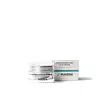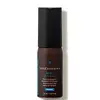What's inside
What's inside
 Key Ingredients
Key Ingredients

 Benefits
Benefits

 Concerns
Concerns

 Ingredients Side-by-side
Ingredients Side-by-side

Water
Skin ConditioningC12-15 Alkyl Benzoate
AntimicrobialCetyl Ricinoleate
EmollientSorbitol
HumectantGlycerin
HumectantC12-20 Acid PEG-8 Ester
EmulsifyingSorbitan Stearate
EmulsifyingGlyceryl Stearate
EmollientPEG-100 Stearate
Carthamus Tinctorius Seed Oil
MaskingSodium Potassium Aluminum Silicate
Glycolic Acid
BufferingMyristoyl Pentapeptide-8
Skin ConditioningMyristoyl Pentapeptide-11
Skin ConditioningSh-Polypeptide-9
Skin ConditioningSh-Polypeptide-22
Skin ConditioningSh-Oligopeptide-4
Skin ConditioningAloe Barbadensis Leaf Juice
Skin ConditioningSodium Hyaluronate
HumectantSaccharomyces Cerevisiae Extract
Skin ConditioningChamomilla Recutita Flower Extract
MaskingAleurites Moluccanus Seed Oil
Skin ConditioningMacadamia Ternifolia Seed Oil
EmollientRosmarinus Officinalis Leaf Extract
AntimicrobialRetinyl Palmitate
Skin ConditioningCamellia Sinensis Leaf Extract
AntimicrobialSaccharum Officinarum Extract
MoisturisingCitrus Medica Limonum Fruit Extract
Skin ConditioningCitrus Aurantium Dulcis Fruit Extract
MaskingPyrus Malus Pulp Extract
Skin ConditioningRetinyl Palmitate/Carrot Polypeptide
Skin ConditioningAscorbyl Palmitate
AntioxidantAscorbic Acid
AntioxidantCitric Acid
BufferingTocopherol
AntioxidantLecithin
EmollientHydrogenated Phosphatidylcholine
EmulsifyingSodium Hydroxide
BufferingPEG-8
HumectantXanthan Gum
EmulsifyingSodium Oleate
CleansingGlycine Soja Oil
EmollientParfum
MaskingLimonene
PerfumingLinalool
PerfumingSilica
AbrasiveDisodium EDTA
Caprylyl Glycol
EmollientEthylhexylglycerin
Skin ConditioningHexylene Glycol
EmulsifyingBenzoic Acid
MaskingPhenoxyethanol
PreservativeCI 40800
Cosmetic ColorantCI 77891
Cosmetic ColorantWater, C12-15 Alkyl Benzoate, Cetyl Ricinoleate, Sorbitol, Glycerin, C12-20 Acid PEG-8 Ester, Sorbitan Stearate, Glyceryl Stearate, PEG-100 Stearate, Carthamus Tinctorius Seed Oil, Sodium Potassium Aluminum Silicate, Glycolic Acid, Myristoyl Pentapeptide-8, Myristoyl Pentapeptide-11, Sh-Polypeptide-9, Sh-Polypeptide-22, Sh-Oligopeptide-4, Aloe Barbadensis Leaf Juice, Sodium Hyaluronate, Saccharomyces Cerevisiae Extract, Chamomilla Recutita Flower Extract, Aleurites Moluccanus Seed Oil, Macadamia Ternifolia Seed Oil, Rosmarinus Officinalis Leaf Extract, Retinyl Palmitate, Camellia Sinensis Leaf Extract, Saccharum Officinarum Extract, Citrus Medica Limonum Fruit Extract, Citrus Aurantium Dulcis Fruit Extract, Pyrus Malus Pulp Extract, Retinyl Palmitate/Carrot Polypeptide, Ascorbyl Palmitate, Ascorbic Acid, Citric Acid, Tocopherol, Lecithin, Hydrogenated Phosphatidylcholine, Sodium Hydroxide, PEG-8, Xanthan Gum, Sodium Oleate, Glycine Soja Oil, Parfum, Limonene, Linalool, Silica, Disodium EDTA, Caprylyl Glycol, Ethylhexylglycerin, Hexylene Glycol, Benzoic Acid, Phenoxyethanol, CI 40800, CI 77891
Water
Skin ConditioningDipropylene Glycol
HumectantButylene Glycol
HumectantUndecane
EmollientBis-Hydroxyethoxypropyl Dimethicone
EmollientAlcohol Denat.
AntimicrobialAscorbic Acid
AntioxidantDimethicone
EmollientCaprylic/Capric Triglyceride
MaskingTridecane
PerfumingPhloretin
AntioxidantLauryl PEG-9 Polydimethylsiloxyethyl Dimethicone
Skin ConditioningDimethicone/PEG-10/15 Crosspolymer
Dimethicone/Polyglycerin-3 Crosspolymer
CleansingFerulic Acid
AntimicrobialRuscus Aculeatus Root Extract
AstringentCaffeine
Skin ConditioningDisodium EDTA
Sodium Hydroxide
BufferingWater, Dipropylene Glycol, Butylene Glycol, Undecane, Bis-Hydroxyethoxypropyl Dimethicone, Alcohol Denat., Ascorbic Acid, Dimethicone, Caprylic/Capric Triglyceride, Tridecane, Phloretin, Lauryl PEG-9 Polydimethylsiloxyethyl Dimethicone, Dimethicone/PEG-10/15 Crosspolymer, Dimethicone/Polyglycerin-3 Crosspolymer, Ferulic Acid, Ruscus Aculeatus Root Extract, Caffeine, Disodium EDTA, Sodium Hydroxide
Alternatives
Ingredients Explained
These ingredients are found in both products.
Ingredients higher up in an ingredient list are typically present in a larger amount.
Ascorbic Acid is is pure Vitamin C. This form makes up the largest amount of vitamin C found naturally in our skin.
Not only is vitamin C great for your overall health and immune system, it also has plenty of benefits on your skin.
Vitamin C is best used for brightening skin. It improves dark spots, acne scars, and hyperpigmentation. This is because it blocks the process of skin darkening when exposed to UV.
Remember: Vitamin C should not replace sunscreen!
Your skin uses vitamin C to build collagen. Collagen is one key component in having a strong skin barrier and plump skin. Vitamin C also plays a role in regulating collagen, thus making it effective in improving wrinkles and fine lines.
Ascorbic acid shows potent antioxidant activity. As an antioxidant, it helps fight free-radicals. Free-radicals are molecules that may damage your skin cells. These antioxidants also protect skin against UV damage.
The best formulations include Vitamin E and/or ferulic acid. These two ingredients help stabilize and provide a boost in the benefits of ascorbic acid. This is because ascorbic acid becomes unstable when exposed to UV and air. In fact, you can tell your ascorbic acid has oxidized when it turns an orange-yellow color.
Ascorbic acid is generally compatible with other ingredients. However, using ascorbic acid with other active ingredients might cause irritation. Two ingredients: copper ions and benzoyl peroxide, will inactivate ascorbic acid completely.
Read more about other types of Vitamin C:
Foods rich with vitamin C include oranges, strawberries, broccoli, bell peppers, and more. When consuming Vitamin C, your skin receives a portion of the nutrients.
Learn more about Ascorbic AcidDisodium EDTA plays a role in making products more stable by aiding other preservatives.
It is a chelating agent, meaning it neutralizes metal ions that may be found in a product.
Disodium EDTA is a salt of edetic acid and is found to be safe in cosmetic ingredients.
Learn more about Disodium EDTASodium Hydroxide is also known as lye or caustic soda. It is used to adjust the pH of products; many ingredients require a specific pH to be effective.
In small amounts, sodium hydroxide is considered safe to use. However, large amounts may cause chemical burns due to its high alkaline.
Your skin has a natural pH and acid mantle. This acid mantle helps prevent harmful bacteria from breaking through. The acid mantle also helps keep your skin hydrated.
"Alkaline" refers to a high pH level. A low pH level would be considered acidic.
Learn more about Sodium HydroxideWater. It's the most common cosmetic ingredient of all. You'll usually see it at the top of ingredient lists, meaning that it makes up the largest part of the product.
So why is it so popular? Water most often acts as a solvent - this means that it helps dissolve other ingredients into the formulation.
You'll also recognize water as that liquid we all need to stay alive. If you see this, drink a glass of water. Stay hydrated!
Learn more about Water